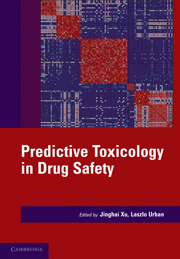Book contents
- Frontmatter
- Contents
- Contributors
- Prologue – Predictive toxicology: a new chapter in drug safety evaluation
- PREDICTIVE TOXICOLOGY IN DRUG SAFETY
- I SPECIFIC AREAS OF PREDICTIVE TOXICOLOGY
- II INTEGRATED APPROACHES OF PREDICTIVE TOXICOLOGY
- 10 Integrated approaches to lead optimization: improving the therapeutic index
- 11 Predictive toxicology approaches for small molecule oncology drugs
- 12 Mechanism-based toxicity studies for drug development
- 13 Fish embryos as alternative models for drug safety evaluation
- 14 The role of genetically modified mouse models in predictive toxicology
- 15 Toxicogenomic and pathway analysis
- 16 Drug safety biomarkers
- 17 Application of TK/PD modeling in predicting dose-limiting toxicity
- 18 Prediction of therapeutic index of antibody-based therapeutics: mathematical modeling approaches
- 19 Vaccine toxicology: nonclinical predictive strategies
- Epilogue
- Index
- Plate section
- References
12 - Mechanism-based toxicity studies for drug development
from II - INTEGRATED APPROACHES OF PREDICTIVE TOXICOLOGY
Published online by Cambridge University Press: 06 December 2010
- Frontmatter
- Contents
- Contributors
- Prologue – Predictive toxicology: a new chapter in drug safety evaluation
- PREDICTIVE TOXICOLOGY IN DRUG SAFETY
- I SPECIFIC AREAS OF PREDICTIVE TOXICOLOGY
- II INTEGRATED APPROACHES OF PREDICTIVE TOXICOLOGY
- 10 Integrated approaches to lead optimization: improving the therapeutic index
- 11 Predictive toxicology approaches for small molecule oncology drugs
- 12 Mechanism-based toxicity studies for drug development
- 13 Fish embryos as alternative models for drug safety evaluation
- 14 The role of genetically modified mouse models in predictive toxicology
- 15 Toxicogenomic and pathway analysis
- 16 Drug safety biomarkers
- 17 Application of TK/PD modeling in predicting dose-limiting toxicity
- 18 Prediction of therapeutic index of antibody-based therapeutics: mathematical modeling approaches
- 19 Vaccine toxicology: nonclinical predictive strategies
- Epilogue
- Index
- Plate section
- References
Summary
INTRODUCTION
Drug attrition during discovery and development continues to be a major hurdle for drug approval. Even as the number of investigational new drug (IND) filings increased between 1986 and 2006, new drug applications (NDA) remained flat during the same time period due to attrition. The major reason for drug attrition in the clinic is preclinical toxicity, accounting for 35 percent of terminated drugs, followed closely by clinical efficacy and clinical safety. Attrition due to preclinical toxicity is even higher (~70 percent) when compounds that fail prior to candidate drug nomination are considered. Toxicologists need to learn from the success of approaches employed in drug metabolism and pharmacokinetics (DMPK) where attrition due to unfavorable PK has been reduced from a high of 40 percent in 1991 to only 6 percent in 2001. This success was achieved by applying a variety of in vivo and in vitro approaches including predictive in silico and in vitro assays prior to preclinical and clinical administration.
The traditional toxicologist manages nominated candidate drugs through the rigors of clinical development; however, in the rising need to reduce drug attrition, there is a paradigm shift in training toxicologists to evaluate the safety of pharmacological targets or new chemical entities (NCEs) through all phases of drug discovery and development. However, toxicologists are faced with a tougher hurdle in reducing attrition than groups in drug metabolism and pharmacokinetics.
- Type
- Chapter
- Information
- Predictive Toxicology in Drug Safety , pp. 230 - 243Publisher: Cambridge University PressPrint publication year: 2010
References
- 2
- Cited by



